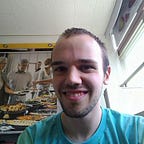Master’s Project- Marvel Network Analysis
This project is a network analysis of Marvel characters and what comics they appear in. The network data can be found here. Python was used to perform the analysis while leveraging several libraries to undertake much of the legwork: networkx, pyvis, and matplotlib.
The network was rather large, containing 18,429 nodes and 94,290 edges. Below is a graph describing the frequency of node degrees.
From the graph above, it is evident that nodes with low levels of degree makeup a majority of the network. Another feature of note is the small concentration of nodes with high levels of degree distribution.
These highly central nodes became the focus of the analysis. Additionally, visualizing a network of this size would prove challenging, therefore, filtering out nodes became a necessary feature of analysis.
Below is a visualization of a subset of the network. Only nodes containing a degree of 75 or higher are present.
This picture is the network subset overview. The broad structure resembles a venn diagram with each circle’s center being a comic cluster, the orbiting nodes are superheroes present in a specific comic series, and the nodes in between all clusters are heroes present in all three.
The three main clusters are the Infinity War, Contest of Champions, and the Incredible Hulk Issue #279. The nodes along the outside are superheroes exclusively present in one cluster while nodes in the middle of the network are superheroes present in all three comic clusters.
The following graphic is an exploration of the most connected superheroes.
The image might be tough to read but there are some notable categories among these connected heroes. First, there are several XMen present, namely Wolverine, Storm, Colossus and Beast. Also, the Fantastic Four are present as well: Thing, Invisible Woman, Mr. Fantastic, and the Human Torch. Lastly, some Avengers are present: Captain America, Dr. Strange, and Hulk. These heroes are connected to the big 3 comic clusters, the most central nodes in the network.
What’s surprising is that some lesser-known heroes like Daredevil the Wasp, and She-Hulk present in all three clusters as well.
For the comic clusters, it’s not surprising that Infinity War is among the most central nodes in the network. With so many characters present in the Infinity War film it would be safe to assume that the comic series could squeeze in even more characters than the movie franchise.
What was surprising was the cluster Incredible Hulk Issue #279 because it wasn’t some grand intergalactic war like Infinity War was. Instead, this issue was just a celebration of Hulk getting full control over his powers.
The comic brought in a variety of heroes from all over the Marvel universe to have a celebratory parade. Bringing all these heroes together to celebrate instead of fight is seemingly uncharacteristic of the Marvel comic book universe. Especially when considering the other two comic clusters.
The last cluster, Contest of Champions, is more akin to Infinity War. Heroes from all over the galaxy are brought together to fight for the amusement of intergalactic gods and out of all three clusters, the Contest of Champions cluster has the highest degree.
